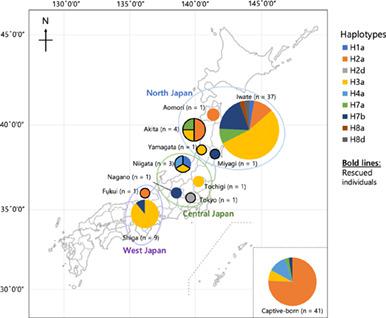当前位置:
X-MOL 学术
›
Ecol. Res.
›
论文详情
Our official English website, www.x-mol.net, welcomes your
feedback! (Note: you will need to create a separate account there.)
Genetic diversity of the endangered Japanese golden eagle at neutral and functional loci
Ecological Research ( IF 1.7 ) Pub Date : 2021-06-16 , DOI: 10.1111/1440-1703.12246 Annegret M. Naito‐Liederbach 1 , Yu Sato 1, 2 , Nobuyoshi Nakajima 3 , Taku Maeda 4 , Takehiko Inoue 5 , Toru Yamazaki 5 , Rob Ogden 2 , Miho Inoue‐Murayama 1
Ecological Research ( IF 1.7 ) Pub Date : 2021-06-16 , DOI: 10.1111/1440-1703.12246 Annegret M. Naito‐Liederbach 1 , Yu Sato 1, 2 , Nobuyoshi Nakajima 3 , Taku Maeda 4 , Takehiko Inoue 5 , Toru Yamazaki 5 , Rob Ogden 2 , Miho Inoue‐Murayama 1
Affiliation

|
The Japanese golden eagle (Aquila chrysaetos japonica) is an endangered subspecies with declining reproductive success. Previous research on this subspecies reported genetic diversity in northern Japan and in captivity using neutral genetic markers, but the situation in other areas of Japan and diversity at functional genetic loci are understudied. Here, we increased wild samples from western Japan and captive samples from zoos and analyzed genetic diversity of mitochondrial DNA, nuclear microsatellite loci, and the major histocompatibility complex (MHC) DRB exon 2 region. In addition, wild Scottish samples were analyzed and literature from European subspecies and other raptor species was surveyed to compare with the Japanese golden eagle. Overall, levels of mtDNA haplotype and microsatellite diversity observed in western Japan were similar to previously studied northern regions. However, microsatellite allelic diversity was lower compared to other golden eagle subspecies. MHC diversity indices, especially in captive Japanese golden eagles, were also low relative to raptors classified as Least Concern by the IUCN. This pattern could be explained by the loss of rare alleles due to genetic drift—a consequence of a declining population—suggesting the possibility of an early population bottleneck. Moreover, genetic structure analyses suggested that the Japanese population likely consists of one gene pool, so the bottleneck may affect the entire population. From these results, we suggest maintaining gene flow between local populations to prevent inbreeding and further loss of alleles, increasing the number of breeding pairs in captivity, and releasing captive individuals to reinforce the wild population.
中文翻译:

濒危日本金雕在中性和功能位点的遗传多样性
日本金雕(Aquila chrysaetos japonica)是一种繁殖成功率下降的濒危亚种。先前对该亚种的研究报告了日本北部和圈养中使用中性遗传标记的遗传多样性,但日本其他地区的情况和功能遗传位点的多样性尚未得到充分研究。在这里,我们增加了来自日本西部的野生样本和来自动物园的圈养样本,并分析了线粒体 DNA、核微卫星位点和主要组织相容性复合体 (MHC) DRB 的遗传多样性外显子 2 区域。此外,对苏格兰野生样本进行了分析,并对欧洲亚种和其他猛禽物种的文献进行了调查,以与日本金雕进行比较。总体而言,在日本西部观察到的 mtDNA 单倍型和微卫星多样性水平与先前研究的北部地区相似。然而,与其他金雕亚种相比,微卫星等位基因多样性较低。MHC 多样性指数,尤其是圈养的日本金雕,相对于被 IUCN 列为最不关心的猛禽也较低。这种模式可以通过遗传漂变导致的稀有等位基因丢失来解释——这是种群下降的结果——表明早期种群瓶颈的可能性。此外,遗传结构分析表明日本人口可能由一个基因库组成,所以瓶颈可能会影响到整个人口。根据这些结果,我们建议维持当地种群之间的基因流动,以防止近亲繁殖和等位基因的进一步丢失,增加圈养繁殖对的数量,并释放圈养个体以加强野生种群。
更新日期:2021-06-16
中文翻译:

濒危日本金雕在中性和功能位点的遗传多样性
日本金雕(Aquila chrysaetos japonica)是一种繁殖成功率下降的濒危亚种。先前对该亚种的研究报告了日本北部和圈养中使用中性遗传标记的遗传多样性,但日本其他地区的情况和功能遗传位点的多样性尚未得到充分研究。在这里,我们增加了来自日本西部的野生样本和来自动物园的圈养样本,并分析了线粒体 DNA、核微卫星位点和主要组织相容性复合体 (MHC) DRB 的遗传多样性外显子 2 区域。此外,对苏格兰野生样本进行了分析,并对欧洲亚种和其他猛禽物种的文献进行了调查,以与日本金雕进行比较。总体而言,在日本西部观察到的 mtDNA 单倍型和微卫星多样性水平与先前研究的北部地区相似。然而,与其他金雕亚种相比,微卫星等位基因多样性较低。MHC 多样性指数,尤其是圈养的日本金雕,相对于被 IUCN 列为最不关心的猛禽也较低。这种模式可以通过遗传漂变导致的稀有等位基因丢失来解释——这是种群下降的结果——表明早期种群瓶颈的可能性。此外,遗传结构分析表明日本人口可能由一个基因库组成,所以瓶颈可能会影响到整个人口。根据这些结果,我们建议维持当地种群之间的基因流动,以防止近亲繁殖和等位基因的进一步丢失,增加圈养繁殖对的数量,并释放圈养个体以加强野生种群。











































 京公网安备 11010802027423号
京公网安备 11010802027423号